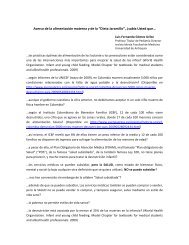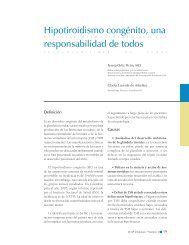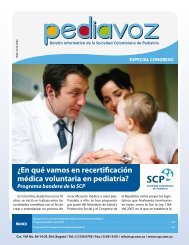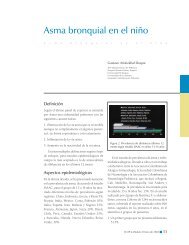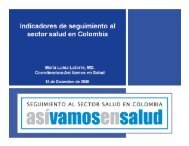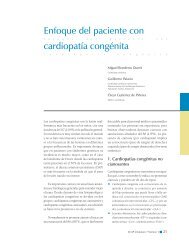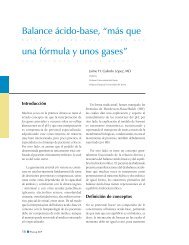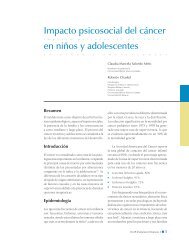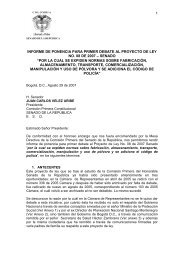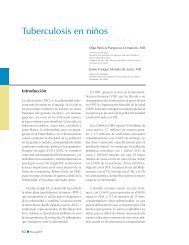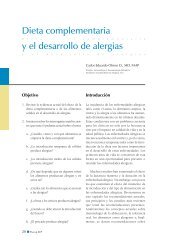82 :: Evaluación <strong>de</strong> la calidad basada en evi<strong>de</strong>ncia en infección urinaria pediátrica en un hospital universitarioABSTRACTBackground: compliance with sound evi<strong>de</strong>nce-based (EB) recommendations is used to measure quality of healthcare. After implementing a locally <strong>de</strong>veloped EB gui<strong>de</strong>line for the management of Urinary Tract Infection (UTI) inchildren, there were data suggesting that UTI management in a university hospital continued to be inappropriate.Objectives: 1. Developing EB indicators of quality of UTI care; 2. Measuring clinicians’ compliance with recommendations;and 3. Proposing a quality assurance strategy.Methods: an evaluation of clinician’s performance before and after implementing an EB gui<strong>de</strong>line. Specific stepsinclu<strong>de</strong>d: 1. I<strong>de</strong>ntifying 33 clinical <strong>de</strong>cision points for which the gui<strong>de</strong>line ma<strong>de</strong> recommendations; 2. Retrievingdata from a sample of clinical encounters occurring 9 months before and after implementing the gui<strong>de</strong>line; 3.Auditing each encounter checking 33 EB indicators; 4. Constructing a scale with 12 key indicators; 5. Scoring theencounters; and 6. Comparing scores before and after implementing the gui<strong>de</strong>line.Results: during the study period (18 months) there were 128 eligible encounters (63 and 65 before and afterimplementing the gui<strong>de</strong>line, respectively). Eighteen encounters (14%) had unacceptable quality, 11 (8,5%) and 7(5,4%) in the before and after, respectively. Median quality scores (1-3 quartile) were 71 (56-80) for the first periodand 80 (65-82) for the second.Conclusions: there was a mo<strong>de</strong>st improvement in compliance after gui<strong>de</strong>line implementation, with ample roomfor improvement. These findings suggest that implementation of a gui<strong>de</strong>line by itself might not maximize the qualityof clinical care.Key words: Urinary tract infections; Practice gui<strong>de</strong>lines; Quality assurance in health care; Clinical performance;Evi<strong>de</strong>nce-based medicine.INTRODUCCIÓNPor calidad <strong>de</strong> la atención en salud suele enten<strong>de</strong>rselos niveles <strong>de</strong> excelencia que caracterizan aun servicio <strong>de</strong> salud o a la atención dispensada encomparación con estándares aceptados <strong>de</strong> calidad.Sin embargo, esta <strong>de</strong>finición es difícil <strong>de</strong> traducira términos operativos. Para evaluar la calidad <strong>de</strong>la atención suelen medirse 11 atributos 1, 2 : oportunidad,continuidad, suficiencia e integridad, racionalidadlógico-científica, satisfacción <strong>de</strong>l usuario y<strong>de</strong>l proveedor, efectividad, eficiencia, optimización,aceptabilidad, legitimidad y equidad.Donabedian (1980) es el principal pensadorcontemporáneo acerca <strong>de</strong> calidad en salud. Elnúcleo <strong>de</strong> su <strong>de</strong>finición <strong>de</strong> calidad es el balanceentre daño (riesgo) y beneficio en salud. Para lamedición <strong>de</strong> la calidad <strong>de</strong> la atención en salud,Donabedian propone consi<strong>de</strong>rar tres elementos<strong>de</strong> los servicios en salud, así: a) su estructura;b) los procesos involucrados y c) los resultados o<strong>de</strong>senlaces obtenidos (enfocados en el pacienteo cliente) 3 . Estos tres aspectos mensurables <strong>de</strong> lacalidad están íntimamente interrelacionados. Lasestructuras <strong>de</strong> los sistemas y los servicios <strong>de</strong> saludproveen la infraestructura física, financiera y administrativa(necesaria, pero insuficiente para asegurarla calidad) sobre la cual se <strong>de</strong>sarrollan los procesos.Estos últimos conducen a la realización <strong>de</strong> accionesespecíficas que son, en último término, los productosfinales que se entregan a los pacientes. Estosproductos abarcan dos componentes que integranla atención en salud: las intervenciones y los servicios.Para efectos <strong>de</strong> esta discusión se enten<strong>de</strong>rá comointervención en salud (preventiva o curativa)PEDIATRÍA - VOL 41 No. 2 - 2006
Evaluación <strong>de</strong> la calidad basada en evi<strong>de</strong>ncia en infección urinaria pediátrica en un hospital universitario :: 83cualquier actividad o conjunto <strong>de</strong> activida<strong>de</strong>sdiagnósticas, preventivas y terapéuticas, usualmenterealizadas directamente por el personalclínico. Por servicios en salud se entien<strong>de</strong> todaslas activida<strong>de</strong>s diferentes <strong>de</strong> las intervencionesque permiten llevar a cabo estas en los sujetos(pacientes) objeto <strong>de</strong> las mismas: entrega <strong>de</strong>medicamentos, citas, transporte, guía administrativa,etc., que usualmente no son realizadas porclínicos, sino por el personal administrativo y <strong>de</strong>soporte vinculado a las instituciones <strong>de</strong> atenciónen salud. La combinación <strong>de</strong> los dos constituyelos productos (procesos) <strong>de</strong> los que se componela atención en salud.Las activida<strong>de</strong>s encaminadas a asegurary mejorar la atención en salud pue<strong>de</strong>n dividirseen: a) Activida<strong>de</strong>s <strong>de</strong> control y mejoramiento <strong>de</strong>gestión: ¿se cumplen los objetivos propuestos paraque el sistema genere y entregue los productosen salud planeados?, ¿Los recursos <strong>de</strong>stinados ala generación <strong>de</strong> dichos productos son utilizadoseficientemente? Estas activida<strong>de</strong>s se enfocanmucho más en el mantenimiento y mejoramiento<strong>de</strong> la estructura. b) Activida<strong>de</strong>s <strong>de</strong> evaluación,control y mejoramiento <strong>de</strong> procesos: ¿se ajustanlas características <strong>de</strong> los productos (procesosque involucran la realización <strong>de</strong> intervencionesy servicios) a unos estándares preestablecidos <strong>de</strong>calidad? c) Evaluación <strong>de</strong> resultados o <strong>de</strong>senlaces:¿mejora el estado <strong>de</strong> salud <strong>de</strong> los usuarios comoresultado <strong>de</strong> las intervenciones recibidas?, ¿Estánsatisfechos, no solo con el contenido <strong>de</strong> las intervenciones(satisfacción <strong>de</strong> necesida<strong>de</strong>s), sino conla manera como estas se llevan a cabo (satisfacción<strong>de</strong> expectativas)?Tradicionalmente la evaluación <strong>de</strong> calidadse ha centrado en la medición <strong>de</strong> las características<strong>de</strong> estructura y procesos, y su comparacióncon unos estándares. En el caso <strong>de</strong> la estructura,generalmente los estándares son explícitos yestablecidos <strong>de</strong> antemano, bien sea en la forma<strong>de</strong> requisitos mínimos (calidad <strong>de</strong> conformidad) o<strong>de</strong> requisitos <strong>de</strong>seables (calidad según requisitos).En cuanto a los procesos, la metodología ha sidomás bien confusa. Por lo general, la evaluación<strong>de</strong> procesos no se realiza <strong>de</strong> forma sistemática yrutinaria, sino más bien <strong>de</strong> manera reactiva y aposteriori, frente a la aparición <strong>de</strong> problemas o porquejas <strong>de</strong> los usuarios. Se suele hacer auditoría<strong>de</strong> historias clínicas o, menos frecuentemente,revisión <strong>de</strong>l cumplimiento <strong>de</strong> indicadores. En laprimera, se recurre a expertos escogidos <strong>de</strong> formano sistemática, quienes emiten un juicio sobre losprocesos consignados en la historia, sin que se lescompare contra estándares explícitos. Entre tanto,en la segunda, se contrasta a los procesos actualescon los procedimientos “i<strong>de</strong>ales” o <strong>de</strong> referencia,usualmente formulados con base en las opiniones<strong>de</strong> grupos <strong>de</strong> expertos, las cuales no necesariamenteestán basadas en evi<strong>de</strong>ncia científica sólida y/orelevante. Adicionalmente, estas evaluaciones<strong>de</strong> calidad no tienen en cuenta, o solo lo hacen<strong>de</strong> manera marginal y superficial, los resultados o<strong>de</strong>senlaces en materia <strong>de</strong> salud que experimentanlos pacientes expuestos a las estructuras y procesos<strong>de</strong> interés. En otras palabras, la calidad <strong>de</strong> atenciónes buena si la estructura <strong>de</strong>l servicio está enconformidad con unos estándares y los procesos seajustan a la “buena práctica clínica” aun cuandolos resultados sean <strong>de</strong>sfavorables.Por este motivo surge el movimiento <strong>de</strong>evaluación <strong>de</strong> <strong>de</strong>senlaces como medida <strong>de</strong> la calidad<strong>de</strong> atención, en un intento por solucionar losproblemas <strong>de</strong> una evaluación <strong>de</strong> procesos basadaen estándares variables y en ocasiones arbitrarios,y que muchas veces ni siquiera resultan ser explícitos.Esta ten<strong>de</strong>ncia se consolidó en la década<strong>de</strong> los 80 y se presentó como contraposición a laevaluación basada en procesos. Sin embargo, laevaluación por <strong>de</strong>senlaces no carece <strong>de</strong> <strong>de</strong>bilida<strong>de</strong>sPEDIATRÍA - VOL 41 No. 2 - 2006



